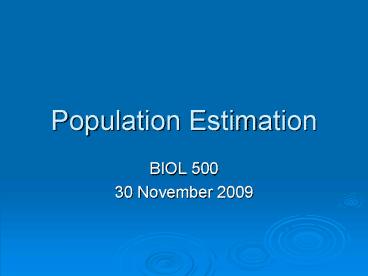Population Estimation PowerPoint PPT Presentation
1 / 25
Title: Population Estimation
1
Population Estimation
- BIOL 500
- 30 November 2009
2
Population Estimation
- Goal Estimate N, to.
- test population-growth models.
- compare relative abundance.
- track game species.
- track endangered species.
3
Total Count
- Rarely possible, except with small populations of
large, conspicuous animals or plants - Exs Whooping cranes (188 in recent aerial
- count of nesting grounds)
- Large mammals
- Trees
4
Sampling and Extrapolation
- Ex Zebra mussels discovered in Edinboro Lake in
Oct. 2000 (data from Jim Grazio, DEP) - 45 randomly-chosen sampling stations
- Attention to depth and littoral zone distribution
by depth - Peaks
- 271 mussels/m2 at 0.76 m in Nov. 2000
- 76 mussels/m2 at 1.3 m in May 2001
- Total estimate of 37,273,524 in Nov. 2000, prior
to lake draw-down - Population down to just 21,991,379 in May 2001
5
Line Transect Estimates
- Observer moves in straight line through habitat
- Records for each specimen seen its perpendicular
distance to the transect - Equations give density by assuming declining
observability with distance from transect
6
HANDOUTLacki et al. 1994
7
Index of Relative Abundance
- Quantifications that do not yield estimates of N
and thus are only useful on a comparative basis - Catch per trap-night or per unit effort
- Counting feces, burrows, mud chimneys of
crayfish, gorilla nests, etc. - Listening for calls
8
HANDOUTNelson and Graves 2004
9
Mark-Release-Recapture Methods
- Rely on the ratio of markedunmarked animals in
subsequent samples - Model assumptions are vitally important
- Lincoln-Peterson method
- Schnabel method (aka Schumacher-Eschmayer method)
- Jolly-Seber method (aka Jolly-Seber-Cormack
method)
10
Lincoln-Peterson Estimator
- Two samples
- N total population (unknown)
- n total captured in second sample
- m marked animals captured in second sample
- M total marked and released during first sample
(assumed to be present when second sample is
taken)
11
Lincoln-Peterson Estimator
- n/N ? m/M
- Proportion of total population
- caught in the second sample left
- approximately equal to
- proportion of the marked population
- caught in the second sample right
- N (nM)/m
12
Fig. 8.4 p. 119
N (2016)/5 64
13
Critical Assumptions of the Lincoln-Peterson
Estimator
- n/N ? m/M if and only if
- a) No marks are lost.
- b) The population is closed.
- c) Marked and unmarked animals are equally
catchable. - Trap-happy or trap-shy behavior would
introduce bias into estimate of N
14
Schnabel Estimator
- Multiple recapture censusing periods
- Yields weighted average of L-P estimates
- N ?niMi / ?mi 1
15
Critical Assumptions of theSchnabel Estimator
- Same three as for L-P
16
Jolly-Seber Estimator
- Published simultaneously in Biometrika in 1965
- Allows for an open population
- Series of estimates of Ni (allowed to vary)
- Also, estimates of rate of loss and number of
additions between sampling periods - Key estimate Mi, rather than simply keeping a
running log of how many animals have been marked
and released
17
Fig. 8.2 p. 116
18
New Variables for the J-S Estimator
- Zi animals caught prior to i, not at i, and
after i - Assumed present at i, but not caught at that time
- Ri animals caught at i and at least once again
thereafter
19
HANDOUTKrebs 5th edition
20
J-S Equation
- Zi /Mi mi ? Ri /ni
- The proportion of marked animals present at i
which - we do not account for then, but do later left
- approximately equal to
- proportion of the total catch at i that we catch
later right - Mi Zi ni /Ri mi
- Thus Ni niMi /mi
21
Critical Assumptions of the J-S Estimator
- 1) No loss of marks
- 2) No individual variation in capture probability
- 3) No animals leave, then re-enter the population
- Doing so would invalidate Zi
22
Sample Calculations
- Z3 5221884 39
- R3 33138 54
- M3 (39?164)/54 37 155
- N3 (169?155)/37 708
23
Calculating Survivorship Rates
- pi survivorship rate, i to i1
- Mi1/Mi ni mi
- ni mi represents new marked animals
- Ex p3-4 205/155 164 37 0.727
- Estimates that 72.7 remain in the
populationalive and not emigratedbetween Sample
3 and Sample 4
24
Calculating Numbers of Additions
- Bi number of births, i to i1
- Ni1 Nipi
- Ex B3-4 765 (708?0.727) 250
- Estimates 250 new animals (births immigrants)
between Sample 3 and Sample 4
25
HANDOUTRegehr et al. 2006

